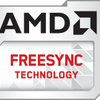AMD FreeSync Explained
AMD FreeSync
To understand Both FreeSync and G-Sync as a technology I will repeat and explain this at least a couple of times times. Here's the thing, your games are not rendered at a fixed consistent frame rate. The graphics card is always firing of frames towards your monitor as fast as it can possibly do frame for frame.
As such these frames are dynamic and can easily bounce from say 30 to 80 FPS in an matter of a split second depending on variables like 3D scene, polygon count, texture quality, user interaction, effects shaders kicking in, etc. On the eye side of things, you have this hardware which is your monitor, and it is a fixed refresh rate device as it refreshes at lets take, 60 Hz (the monitor refreshes and fires off 60 frames at you with each second that passes).
Fixed and dynamic collide
Fixed and dynamic are two different things, they collide with each other. So on one end we have the graphics card rendering at a varying framerate while the monitor wants to show 60 images per second in a timed and sequential interval (I'll use 60Hz screens as example). That causes a problem as with a slower (or faster) FPS then 60, simply put you'll get multiple rendered frames displayed on the monitor with each refresh of the monitor. Graphics cards aren't that good at rendering at fixed speeds, so the industry tried to solve that with VSYNC on or alternatively off. Up-to now we solved problems like Vsync stutter or Tearing basically in two ways. The first way is to simply ignore the refresh rate of the monitor altogether, and update the image being scanned to the display in mid cycle. This you guys all know and have learned as "VSync Off Mode" and is the default way most FPS gamers play. If you however freeze the display to one 1 Hz, this is what you will see, the epiphany of graphics rendering evil, screen-tearing.
We can see that happening in the screenshot below:

Look at the upper and lower part, that is screen tearing - this is FCAT btw - we color each rendered frame with a color bar for analysis.
When a single refresh cycle (1/60th Hz on your monitor) shows 2 or more images, a very obvious tear line is visible at the break, yup, that is what we all refer to this as screen tearing -- and each and eveyone of you have seen it many times.
You can solve tearing though by turning VSYNC ON, but that does create a new problem. See, delaying the graphics card creates an effect as that delay causes stutter whenever the GPU frame rate is below the display refresh rate. There's another nasty side effect mouse LAG. How many of you guys have been irritated by incorrect and laggy mouse input during gaming? Yes, VSYNC delays the rendered GPU frames and the difference in-between the two is responsible for the actual lag that you are experiencing.
So it increases frame latency, which is the direct result for what you guys know and hate -- input lag, the visible delay between a button being pressed and the result occurring on-screen.
My gawd man- how do we fix this madness ?
With FreeSync, or Adaptive Sync or Gsync the monitor will become a slave to your graphics card as the its refresh rate in Hz becomes dynamic. Yes, it is no longer functioning in a static refresh rate at 60Hz.
Each time your graphics card has rendered one frame (one draw) that frame is aligned up with the monitor refresh rate (scan). So the refresh rate of the monitor has become dynamic and is now synchronized with the GPU.
With both the graphics card and monitor both dynamically and totally synchronized you have effectively eliminated three things; stutter, input lag and screen tearing. It gets even better, without stutter and screen tearing on an nice IPS LCD panel even at say 35 Hz you'd be having an pretty good gaming experience (visually) as the perception of a smoothly rendered game is just so much higher. One note here, FreeSync is limited to refresh rates between 9 and 240Hz, but those limitations are beyond what any current monitor is reasonably capable of (most LCDs call within the 30Hz to 144Hz range).
What about FreeSync support ?
Anything with a DisplayPort 1.2a or eDP (embedded Displayport) AMD Radeon wise inevitably will be supported pretty much meaning AMD Radeon graphics cards in the AMD Radeon HD 7000, HD 8000, R7 or R9 Series will inevitably support FreeSync for video playback and power-saving purposes. The AMD Radeon R9 295X2, 290X, R9 290, R7 260X and R7 260 GPUs additionally feature updated display controllers that will support dynamic refresh rates during gaming. AMD APUs codenamed "Kaveri," "Kabini," "Temash," "Beema" and "Mullins" also feature the necessary hardware capabilities to enable dynamic refresh rates for video playback, gaming and power-saving purposes. All products must be connected to a display that supports DisplayPort Adaptive-Sync. The software architecture of select games may not be compatible with dynamic refresh rate technology like FreeSync. In these instances, users will be able to toggle the activation of FreeSync in the AMD Catalyst driver.




